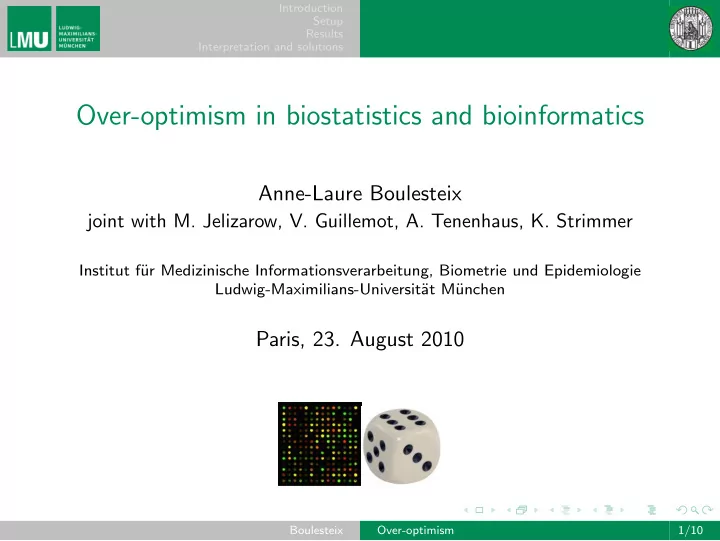

Introduction Setup Results Interpretation and solutions Over-optimism in biostatistics and bioinformatics Anne-Laure Boulesteix joint with M. Jelizarow, V. Guillemot, A. Tenenhaus, K. Strimmer Institut f¨ ur Medizinische Informationsverarbeitung, Biometrie und Epidemiologie Ludwig-Maximilians-Universit¨ at M¨ unchen Paris, 23. August 2010 Boulesteix Over-optimism 1/10
Introduction Setup Results Interpretation and solutions Bias in reporting error rates: An empirical study ◮ Setup: supervised classification based on high-dimensional data like microarray data ◮ Many available methods (SVM, lasso, etc) but no consensus ◮ Cross-validation is often used to estimate error rates. ◮ Choosing the classification method a posteriori based on the estimated error rates yields a strongly optimistic estimate: the minimal error rate was as low as 31% (!!) with permuted class labels for a colon cancer data set in our empirical study. A.-L. Boulesteix, C. Strobl, 2009. Optimal classifier selection and negative bias in error rate estimation: An empirical study on high-dimensional prediction. BMC Medical Research Methodology 9:85. Boulesteix Over-optimism 2/10
Introduction Setup Results Interpretation and solutions Bias in methodological research ◮ When developing statistical methods, researchers often think of several possible variants (called “methods’ characteristics” here). ◮ If they choose the methods’ characteristics a posteriori (i.e. because they obtain nice results with these characteristics), the results of the new method are also optimistically biased! Here we present an empirical study to illustrate this bias and the need for validation with independent data. Boulesteix Over-optimism 3/10
Introduction Setup Results Interpretation and solutions A “promising” method Discriminant function in linear discriminant analysis: d r ( x ) = x ⊤ Σ − 1 µ r − 1 r Σ − 1 µ r + log( π r ) , 2 µ ⊤ Problem: The sample estimator ˆ Σ of the covariance matrix Σ is not invertible when n ≪ p ! Solution: Use a regularized estimator of Σ instead of the ˆ Σ, for instance the shrinkage estimator by Sch¨ afer and Strimmer (2005): Σ ∗ = λ ˆ ˆ Σ + (1 − λ ) T , where T is an adequately chosen target and λ a shrinkage parameter. Boulesteix Over-optimism 4/10
Introduction Setup Results Interpretation and solutions A “promising” method Idea: Define T using priori knowledge on the gene function groups (GFG): Target D Target G if i = j s ii � s ii if i = j r √ s ii s jj t ij = t ij = ¯ if i � = j , i ∼ j 0 if i � = j 0 otherwise Problem: How should we deal with genes that are in no GFG, genes that are in several GFG, negative correlations within GCG, non-significant correlations? → 10 candidate variants Boulesteix Over-optimism 5/10
Introduction Setup Results Interpretation and solutions Selecting the methods’ characteristics optimally The error rate can be decreased by optimizing the “methods’ characteristics” (i.e. by choosing the optimal variant for a particular data set). Boulesteix Over-optimism 6/10
Introduction Setup Results Interpretation and solutions Selecting the methods’ characteristics optimally M opt s opt Golub CLL Wang Singh rlda.TG (5) Golub s opt = (200, Limma) 0.025 0.180 0.345 0.152 rlda.TG (5) CLL s opt = (200, Wilcoxon test) 0.079 0.129 0.363 0.141 rlda.TG (6) Wang s opt = (200, t-test) 0.029 0.221 0.342 0.115 rlda.TG (8) Singh s opt = (100, Limma) 0.033 0.274 0.384 0.078 ◮ Seemingly good results are obtained by “fishing for significance” (i.e. optimizing the variable selection setting and the methods’ characteristics). ◮ These seemingly good results cannot be validated based on other data sets. Boulesteix Over-optimism 7/10
Introduction Setup Results Interpretation and solutions Sources of the problems Results presented in statistical bioinformatics papers are sometimes the product of intense optimization: optimization of the settings and optimization of the methods characteristics. ◮ Problem 1: Error rate estimators have high variance in n ≪ p settings, hence the opportunity for optimization. ◮ Problem 2: In methodological research we are interested in the unconditional error rate of the method. Since variability between data sets is high, several data sets are needed. Boulesteix Over-optimism 8/10
Introduction Setup Results Interpretation and solutions Some (partial) solutions ◮ Internal cross-validation? → not for the methods’ characteristics → would not address the (most important) variability between data sets ◮ Check the superiority of the new method using other ”validation” data sets. ... But the unbiased selection of appropriate data sets is a non-trivial task! ◮ Pay more attention to the substantive context. ◮ Publish negative results? Jelizarow et al, 2010. Over-optimism in bioinformatics: an illustration. Bioinformatics 26:1990–1998. Boulesteix, 2010. Over-optimism in bioinformatics research (letter to the editor). Bioinformatics 26:437–439. Boulesteix Over-optimism 9/10
Introduction Setup Results Interpretation and solutions Thanks for your attention! Thanks to V. Guillemot, M. Jelizarow, K. Strimmer (University Leipzig), C. Strobl, A. Tenenhaus (Ecole Sup´ elec). The papers: ◮ M. Jelizarow, V. Guillemot, A. Tenenhaus, K. Strimmer, A.-L. Boulesteix, 2010. Over-optimism in bioinformatics: an illustration. Bioinformatics 26:1990–1998. ◮ A.-L. Boulesteix, 2010. Over-optimism in bioinformatics research. Bioinformatics 26:437–439. ◮ A.-L. Boulesteix and C. Strobl, 2009. Optimal classifier selection and negative bias in error rate estimation: An empirical study on high-dimensional prediction. BMC Medical Research Methodology 9:85. Boulesteix Over-optimism 10/10
Recommend
More recommend